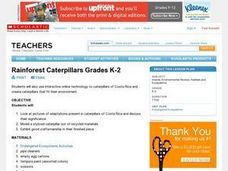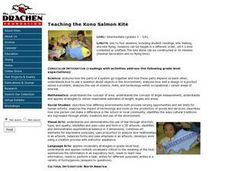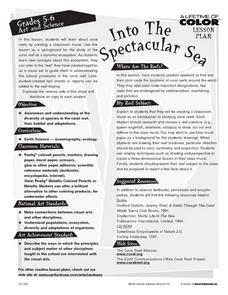Curated OER
The Connection Between Pigment and Light Colors
Students explain the mole concept and use this concept to prepare chemical solutions of particular molarities.
Curated OER
Rainforest Caterpillars Grades K-2
Students are told that after they discuss and examine of rainforest caterpillars, they are going to create their own rainforest caterpillar based on the information they have studied. They are given the habitat scenarios on 3x5 cards.
Curated OER
Side by Side: Butterfly Wings and Symmetry
Students observe butterfly images and then draw and paint their own design. They use this activity to explain symmetry.
Alabama Learning Exchange
Peeking At Pumpkins
Students listen to a read aloud about the life cycle of the pumpkin and discuss the process. They complete a life cycle booklet.
Curated OER
Travel to the Polar Lands
Second graders receive an "Expedition Ticket" to travel through the Polar Regions- the Arctic and the Antarctic. They research polar bears and make drawings that are to scale.
Curated OER
Cartography
Students follow directions to draw a map of an island. They complete the island map adding their own details using symbols and a legend.
Curated OER
Sunflowers (Grades 3-8)
Students examine sunflowers and discuss the importance of sunflower cooking oil and seeds. They view pictures, read books, sing sunflower songs, and grow flowers from sunflower seeds.
Curated OER
Teaching the Kono Salmon Kite
Students complete several student readings involving kite making and kite flying. They analyze how the parts of a system go together and how these parts depend on each other. They comprehend how different environments both provide...
Curated OER
Animal Coverings and Homes
First graders research what kind of coverings living organisms have, and where those organisms live before they can understand how to group them. The following activities will precede the "animal groups" centers, and therefore allow them...
Curated OER
Ocean Life Mural
Students conduct Internet research on ocean life, view pictures of sea life, and create a class ocean life mural.
Curated OER
Wild Kingdom
Students research and discuss the natural habitats and various evolutionary theories of giraffes and other animals imported into ancient Rome.
Curated OER
The Oceans Below
Students investigate the geological characteristics of the ocean environment and create a labeled drawing of the ocean floor's geography. Students view videos and conduct Internet research about the ocean's floor and then create their...
Curated OER
Ecosystem Interactions Web
Students pick an ecosystem (forest, desert, coral reef, open ocean, grassland, mountain, savanna, etc.) and design an interaction web for their chosen ecosystem. Each group shares their ecosystem's web of life with the class.
Curated OER
Classification and Attributes
Middle schoolers classify objects based on their attributes. They explain how archaeologists use classification to help answer research questions.
Curated OER
Leaf Unit
Students complete a unit on leaves and their functions. They identify leaves and the trees they belong to, read various books, observe the process of photosynthesis on a flannel board, and create a leaf collage.
Curated OER
The Journey of a Red Blood Cell
Fifth graders examine how a red blood cell travels throughout the body. Using a model, they recreate the flow of blood through the heart. They also label the lungs and the differece between the blood that enters the heart and the blood...
Curated OER
Bridge Building
Students explore bridges and how they are constructed. After reviewing materials on bridges, they work in groups to record their findings. They design and construct a bridge using K'NEX or straws and predict which bridge will hold the...
Curated OER
Separating Soup Mix
Students use screens of three sizes to separate a mixture of five solid materials. They plan and conduct simple investigations using appropriate tools, measures, and safety rules and record and report observations, explanations, and...
Curated OER
Into the Spectacular Sea
Students research coral reefs as dynamic ecosystems and the part that each organism plays within that ecosystem. They create a mural of a coral reef.
Curated OER
3 Holiday Projects
Students explore the concept of reusing and recycling everyday materials and make holiday-oriented decorations and gift wrapping. Letters containing environmental issues are composed and sent to political and corporate decision-makers.
Curated OER
How Does Climate Affect Your Environment?
Students access the Global Sun Temperature Project website and research the relationship between the location and climate of a participating school to its building structure. They consider how climate affects the type of structures...
Curated OER
Cotton Ball Lamb
Students are encouraged to recognize animal and the sounds they make. They create a hands-on craft, story-telling and song. Students share each creation with their classmates.
Curated OER
Jumping Frogs
Students create a jumping frog out of construction paper, close pins and pipe cleaners. They predict how far they think their frog jump and then test it out to see how close or far away they were from their prediction.

























